Keywords
|
| Superheterodyne, sensitivity, selectivity |
INTRODUCTION
|
| Traditionally, a radio has been considered to be the ‘box’ that connects to antenna and its purpose is to down convert and filter the desired signal and then digitized the information. Digital receiver can receive any type of modulation both analog and digital modulation standard. The functions of a radio receiver are to select the wanted signal from all those signals picked up by the aerial, to extract the information which has been modulated on to the wanted signal, and then to amplify the signal to the level necessary to operate the loudspeaker or other receiving devices[1]. The radio receiver can cause interference to the nearby radio because the receiver only receives signals and does not transmit signals. The source of this interference is the local oscillator (LO) used in the receiver. The local oscillator usually creates an intermediate frequency (IF) at 10.7MHZ for the FM receiver. It implies that the local oscillator is tuned such that IF is always maintained. |
| The most common of receiver is super heterodyne receiver and its architecture is chosen for this project. In communication, a super-heterodyne receiver (or often called superhet) uses the frequency mixing or heterodyning to convert a received signal to a fixed intermediate frequency (IF), which can be more conveniently processed than the original radio carrier frequency. Increase in the number of the FM and AM stations has led to high rate of interference between stations. This interference leads to poor sound quality of a simple AM/FM receiver; research findings have shown that the use of wrong component and poor ICs are the major causes of this interference and other drawbacks of a receiver system. These drawbacks include, cross modulation, local oscillator radiation and blocking [2]. |
| The aim of this research work is to eliminate these problems by introducing a TDA7000 which is a simple monolithic integrated circuit. TDA7000 contains all the stages of FM superhet i.e.; the RF input stage, mixer, local oscillator, IF amplifier/limiter, phase demodulator, mute detector and mute switch. This work equally proposes the use of ZN414Z IC, for the design of AM radio receiver. ZN414Z IC features include single cell operation, low current consumption, full coverage of medium and long wideband, easy to assemble, simple and effective AGC section and excellent audio quality. |
REVIEW OF LITERATURE
|
| In radio transmission, a radiating antenna is use to convert a time-varying electric current into an electromagnetic wave, which freely propagates through a non conducting medium such as air or space and is nothing more than a device built to produce a dispersing electric or magnetic field. The radio frequency spectrum encompasses an extremely wide frequency range; both natural radio energy created by lightening and planetary storms as well as radio frequencies generated by man for communications, entertainment, radar, and television. |
| Brand Brannon and Greensbiro in [3] classified radio receiver into two types; the single-carrier and multi-carrier receiver. The single-carrier receiver is a traditional radio receiver deriving selectivity in the analog filters of the IF stages while the multi-carrier receiver processes all signals within the band with a single RF/IF analog ship and derives selectivity within the digital filters that follows the analog to digital converter. The benefits of the multi-carrier receiver out-weigh that of a single-carrier because it can be applied to design a smaller system at a reduced cost due to elimination of redundant circuits. The authors also outline some technical benefits of designing a digital receiver to include oversampling, processing gain, under-sampling, frequency planning/spur placement. |
| According to the authors in [4], A.M receiver is classified into six types based on the type of pre-detector used. They are crystal receiver, regenerative receiver, super-regenerative receiver, tuned-radio-frequency receiver, superheterodyne receiver and synchrodyne receiver. Crystal set is the simplest form which employs a crystal such as ‘galena’ for a detector and its demerits include poor sensitivity and selectivity and low output. In a regenerative receiver, a negative resistance is introduced into a resonant circuit tuned to the frequency of the signal being received. The basic principle of Tuned-Radio-Frequency Receiver is that all R.F stages are simultaneously tuned to the received frequency before detection and subsequent amplification of the audio signal. In a super-regenerative receiver, a circuit supply intermittent positive feedback is connected to the oscillatory circuit of the radio frequency amplifier stage; the feedback periodically produces self-excited oscillations in the oscillatory circuit and in this case, the amplitude of the oscillations (or the average amplitude) is proportional to the amplitude of the received signal, but it is higher than the signal by a factor of 104 to 105. In reflex receiver, the same amplifier is used simultaneously for pre-detector and post-detector amplification, thus simplifying the design of the receiver. |
| In [5], V.E. Idigo and et al x-ray the functions of different block of a superheterodyne receiver. The authors discuss some of the parameters of a receiver system, such as the interferences, sensitivity, selectivity, ganging and tracking and automatic gain. According to the authors, Co-channel interference occurs as the result of another signal with the same frequency being received by the receiver at the same time with the wanted signal, which cannot be removed by the receiver itself. It occurs as of unusual propagation conditions making it possible for transmission from distance station to be picked up by the aerial. Cross modulation is caused by non-linearity in the RF amplifier or the mixer and results in the transfer of the amplitude modulation of a strong unwanted carrier unto the wanted signal. Ganging is the act of tuning capacitors mounted on a common spindle so that they can simultaneously adjusted so that the resonant circuits of the RF stage must be tuned to that frequency and the tuned circuit of the local oscillator must be tuned to a frequency equal to the sum of the signal and the intermediate frequencies. The maintenance of the correct frequency difference [I.F] between the RF stage and local oscillator frequencies is known as TRACKING. It is possible to achieve nearly perfect tracking over one particular waveband if the plates of the oscillator tuning capacitor are carefully shaped, but this practice requires a different capacitor for each waveband and involves design problems. Most radio receivers use identical tuning capacitors for RF and oscillator circuits and modify the capacitance value by means trimmers and/or padder capacitors. In the view of the authors, the practical result of blocking in that the wanted signal output level falls every time the interfering signal is received and the radiation of the local oscillator frequency does not have a detrimental effect on the local receivers in which it originates but is a source of interference to other nearby receivers. |
METHODOLOGY
|
| The goal of this research work is to model and simulate a superheterodyne FM/AM receiver using a TDA7000 which is a simple monolithic integrated circuit. TDA7000 contains all the stages of FM superhet i.e.; the RF input stage, mixer, local oscillator, IF amplifier/limiter, phase demodulator, mute detector and mute switch. And also the use of ZN414Z IC, for the design of AM radio receiver. ZN414Z IC features include single cell operation, low current consumption, full coverage of medium and long wideband, easy to assemble, simple and effective AGC section and excellent audio quality. The goal of this research is realized through the stage by stage design and implementation of the various components and sections of the superheterodyne FM/AM receiver as shown in figure 1 using Multisim Electronic Software. |
RF Section:
|
| The signal from the antenna is tuned and amplified in a radio frequency (RF) amplifier. The tuned circuit(s) at this stage blocks unwanted frequencies from intended reception frequency. In other to receive a particular station, the frequency of the local oscillator is controlled by tuning knob by the act of ganging. Tuning of the local oscillator at the RF stage may use a variable capacitor. |
Mixer/Converter Section
|
| The signal is then fed into a circuit where it is mixed with a signal from a variable frequency oscillator known as the local oscillator (LO). The mixer uses a non-linear component to produce both the sum and difference beat frequencies signal each one containing the modulation contained in the desired signal. The output of the mixer includes the original RF signal at Fs, the local oscillator signal at Fo and the output is represented as Fs + Fo. The mixer may also produce additional frequencies such as 3rd and higher-order inter-modulation products. The undesired signals are removed by the IF band pass filter, leaving only the desired offset IF as Fif which contains the original transmitted information as the received signal. |
Intermediate Frequency Section
|
| Like the RF amplifier, the IF amplifier must effectively amplify the incoming signal. In the case of intermediate frequencies, amplification and filtering are often utilized simultaneously. It is also not uncommon for several stages of IF amplifiers to be used in succession. Choosing a suitable intermediate frequency is a matter of compromise.The lower the IF used, the easier it is to achieve a narrow bandwidth to obtain good selectivity in the receiver and the greater the IF stage gain. |
| On the other hand, the higher the IF, the further removed is the image frequency from the signal frequency and hence the better the image rejection. The choice of IF is also affected by the selectivity of the RF end of the receiver. If the receiver has a number of RF stages, it is better able to reject an image signal close to the signal frequency and hence a lower IF channel can be tolerated. |
| Another factor to be considered is the maximum operating frequency the receiver. Assuming Q to be reasonably constant, bandwidth of a tuned circuit is directly proportional to its resonant frequency and hence, the receiver has its widest RF bandwidth and poorest image rejection at the highest frequency end of its tuning range. A number of further factors influence the choice of the intermediate frequency: |
| • The frequency should be free from radio interference. Standard intermediate frequencies have been established and these are kept dear of signal channel allocation. If possible, one of these standard frequencies should be used. |
| • An intermediate frequency which is close to some part of the tuning range of the receiver is avoided as this leads to instability when the receiver is tuned near the frequency of the IF channel. |
| • Ideally, low order harmonics of the intermediate frequency (particularly second and third order) should not fall within the tuning range of the receiver. This requirement cannot always be achieved resulting in possible heterodyne whistles at certain spots within the tuning range. |
| • Sometimes, quite a high intermediate frequency is chosen because the channel must pass very wide band signals such as those modulated by 5 MHz video used in television. In this case the wide bandwidth circuits are difficult to achieve unless quite high frequencies are used. |
| • For reasons outlined previously, the intermediate frequency is normally lower than the RF or signal frequency. However, there we some applications, such as in tuning the Low Frequency (LF) band, where this situation could be reversed. In this case, there are difficulties in making the local oscillator track with the signal circuits. |
Detector Stage
|
| The received signal is now processed by the demodulator stage where the audio signal (or baseband signal) is recovered and then further amplified. AM demodulation requires the simple rectification of the RF stage and a simple RC low pass filter to remove remnants of the intermediate frequency. FM signal may be detected using a discriminator or phase-locked loop. |
Audio Section
|
| The function of this section is to amplify the audio signal received from the detector stage and hence provide sufficient power to drive the loudspeaker. |
| TDA7000IC: This is a 20 pin dual monolithic integrated circuit (IC) for mono portable FM radio, where a minimum on peripheral components is important (small dimension and low cost). The pin layout diagram is shown below. |
Telescopic Antenna
|
| The antenna of the receiver system picks up both the wanted and unwanted signal sent out from various transmitting stations. Extremely important factor for good work of simple radio receivers is the outside antenna that has to be long enough, and in which voltages induced by the radio transmitters will be high enough. The length of antenna is being determined in accordance with the "TLTB" law (The Longer, The Better). |
Design of the FM Tank Circuit
|
| C1, C2, C3 and L1 are given in datasheet as 82pf, 68pf, 220pf and 70nH respectively. Therefore the number of turns using copper wire of length 100mm, cross-sectional area (A) of 15mm and μ of 0.999997 will be |
 |
 |
| N ≅ 21turns |
| The total capacitance is |
 |
| Therefore; the modulating frequency (Fmod) is |
 |
| Where L = 70nH and Ct = 31.8pf and substituting in equation 4, we get |
| Fmod ≅ 10.7MHz |
Design of the FM Oscillatory Circuit
|
| Where Cs1, Cv, Cs2, Cp and L2 are 27pf, 270pf, 100nf, 18pf and 78nH respectively. |
| Note that Cp is the parasitic capacitance; Cv is the variable capacitance which has the range of Cvmin as 16pf and Cvmax as 286pf. |
| When we calculate the number of turns of the inductor, where I = 100mm, A = 15mm, and μ = 0.999997; |
 |
| ∴ N ≅ 23 turns |
| Now, we calculate the minimum frequency range as |
| The effective maximum capacitance (Cmax) is calculated thus; |
| Where Cmax is Ctmax + Cp |
| Therefore: |
 (6) (6) |
| Where; |
 (7) (7) |
| Therefore; |
 |
| By Thomson’s formula |
 |
| Where Cmax = 43pf and L2 = 78nH |
 |
| For maximum Frequency range (Fmax) |
| We calculate the effective minimum capacitance (Cmin) |
| Where Cmin is (Ctmin + Cp) |
| Therefore; |
 Cmin = 28pf Cmin = 28pf |
| By Thomson’s formula |
 |
| Where L2 = 78nH and Cmin = 28pf, we get |
| Fmax = 108MHz |
Design of AM Tank and Oscillatory Circuit
|
| This is achieved by the used of the SA612A IC. SA612A IC is a double-balanced mixer and oscillator. The RF inputs (Pins 1 and 2) are biased internally. They are symmetrical. The mixer outputs (Pins 4 and 5) are also internally biased. Each output is connected to the internal positive supply by a 1.5kΩ resistor. This permits direct output termination yet allows for balanced output as well. The oscillatory pin is connected to pins 6 and 7. The circuit diagram is shown below: |
| We first calculate the number of turns for each of the inductor used in this design. Note the values of the length(I) and cross sectional area(A) are 100mm and 15mm respectively and μ = 0.999997. Using similar process as before for the calculation thus; |
 |
| For the oscillatory circuit in pins 6 and 7, we get that the value of the variable capacitance used ranges from Cvmin = 16pf and Cvmax = 286pf. Therefore the minimum modulating frequency (Fmin) and maximum modulating frequency (Fmax) is calculated as before, |
 |
 |
Audio/ Amplifier
|
| The audio amplifier of FM is design with two IC’s (operational amplifier TLO71 as the pre-amplifier, and LM386 as the power amplifier) while that of AM is only built with LM386. The TLO741 is exactly the same as the more famous 741, the only difference lying in fact that TLO71 has the FET on its input, and 741 - the bipolar transistor. The LM386 is a power amplifier designed for use in low volt-age consumer applications. The gain is internally set to 20 to keep external part count low, but the addition of an external resistor and capacitor between pins 1 and 8 will increase the gain to any value from 20 to 200. The LM386 have wide applications both in AM-FM audio amplifier. The two different audios are shown below: |
IMPLEMENTATION, ANALYSIS AND RESULTS
|
FM Implementation
|
| The station signal is from the (telescopic) antenna led to the input circuit (tank Circuits) which has the reception bandwidth from 1MHz to 120MHz the local Oscillator which is tuned to the station frequency is also design to have reception bandwidth form 87MHz to 108MHz. Inside the IC the signals are led into the mixer, where they are being given new carrier frequency called the Intermediate frequency. The IF amplifier then amplify only the signal equal to the intermediate frequency followed by the limiter, the FM detector, and LF pre-amplifier. The output from the last stage is on the pin 2 which is fed in to the audio section and finally to the speaker |
AM Implementation
|
| The station signal is from the (telescopic) antenna led to the double balance mixer SA612 IC (tank Circuit and oscillatory circuit). Inside the SA612 IC the signal are mixed with the modulating frequency of 455KHz (the Intermediate Frequency). The output is fed into ZN414IC which has the reception bandwidth from 150KHz to 3MHz. The local Oscillator which is tuned to the station frequency is also design to have reception bandwidth form 550KHz to 1700KHz. The IF amplifier then amplify only the signal equal to the intermediate frequency followed by the limiter, the FM detector, and LF pre-amplifier. The output from the last stage is on the pin 7 which is fed in to the audio section and finally to the speaker. |
| The graphs below shows the input and output waveforms of the AM and FM receiver respectively. It shows how the small inputs signal generated using signal generators are amplified before it reaches the speaker. |
| It can be seen from the graph that a small audio frequency will produce an output which is about three times that of the input. The results obtained above show how the designed receiver has been able to overcome some of the drawbacks of the regular receivers with improved functionality based on the ICs used in this design. |
CONCLUSION
|
| There are different types of radio receivers which are designed and implemented with different types of components which have been explain in the literature review of this work. This shows the merits of superheterodyne receiver over other types to includes; high sensitivity, better selectivity and simple circuit. |
| The application of TDA7000IC and ZN414IC in the design and construction of superheterodyne FM/AM receiver is very attractive. This is because, they reduce the circuit complexity, assemble cost, improve selectivity and sensitivity. It also reduces rate of interferences. |
Figures at a glance
|
 |
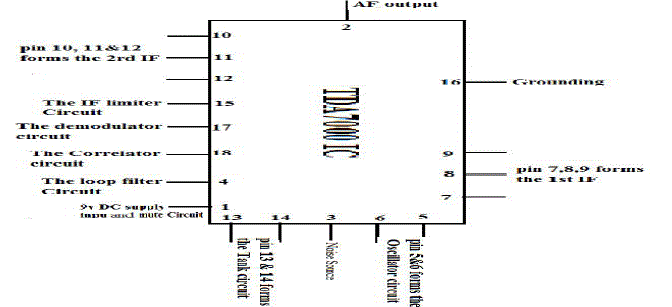 |
 |
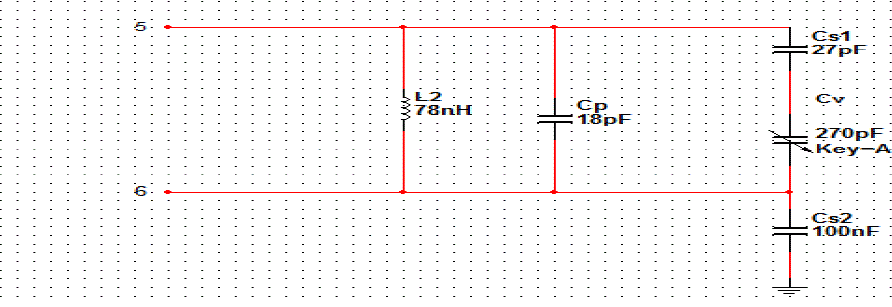 |
| Figure 1 |
Figure 2 |
Figure 3 |
Figure 4 |
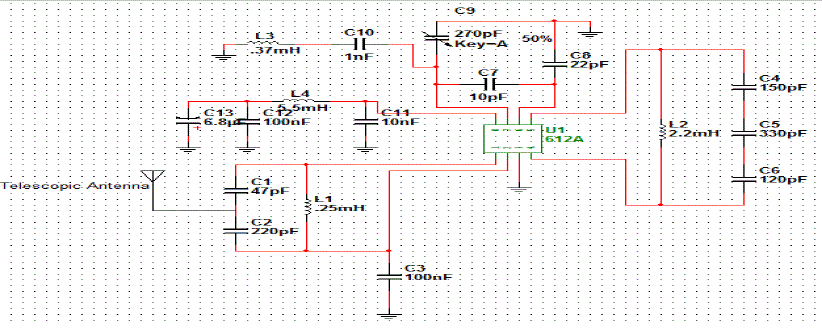 |
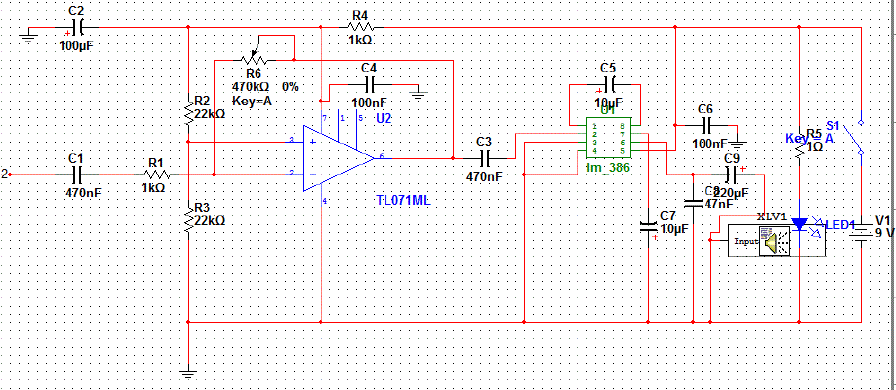 |
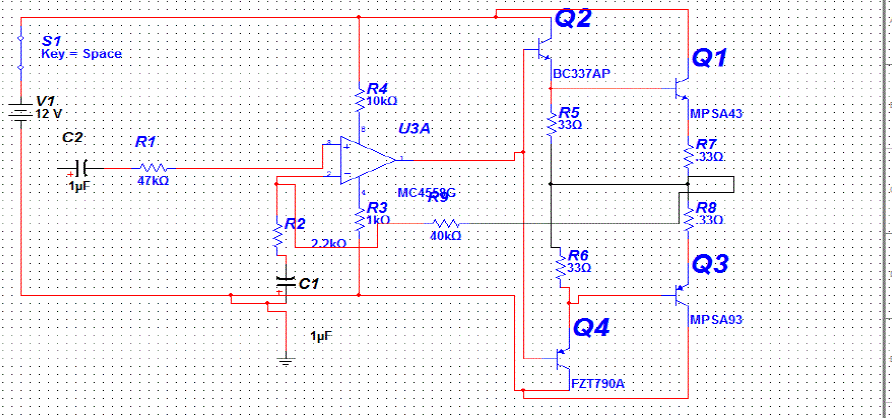 |
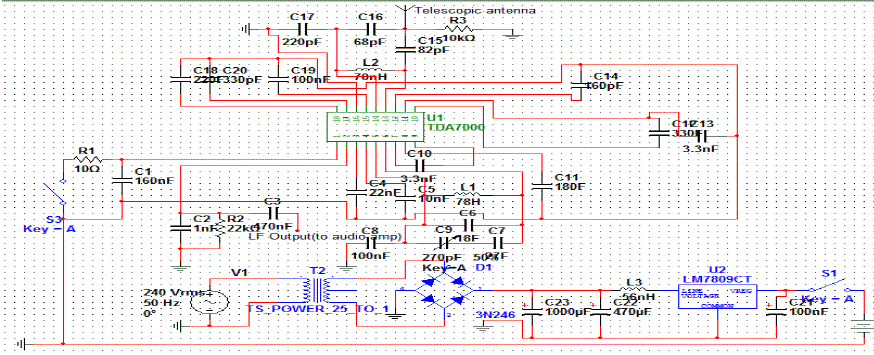 |
| Figure 5 |
Figure 6 |
Figure 7 |
Figure 8 |
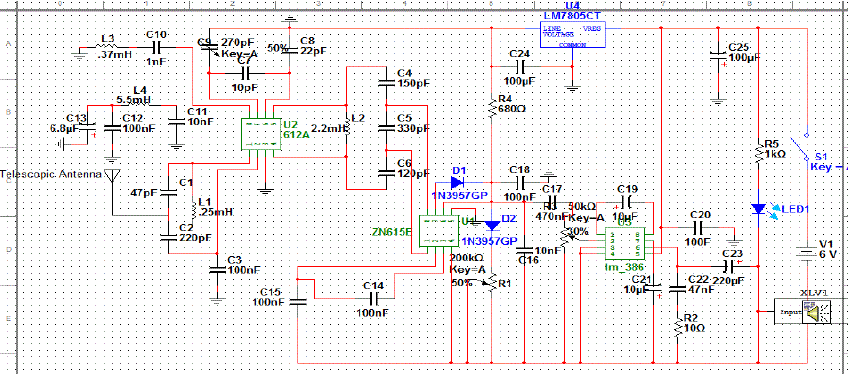 |
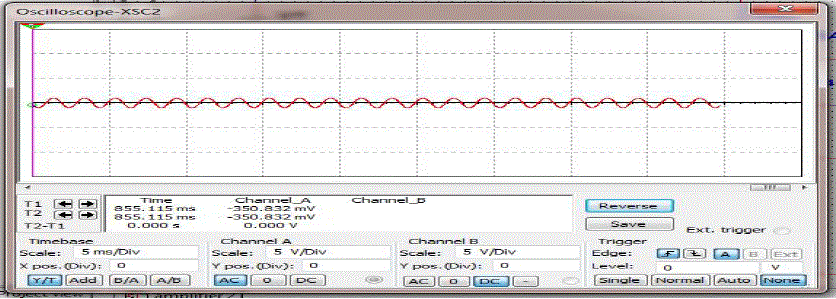 |
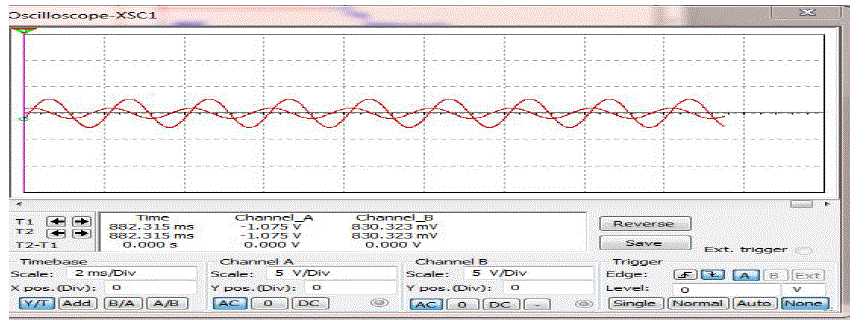 |
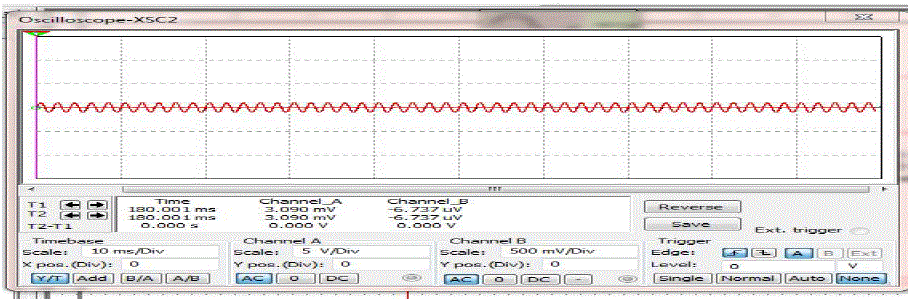 |
| Figure 9 |
Figure 10 |
Figure 11 |
Figure 12 |
|
References
|
- National Instruments “NI Multisim Fundamentals”, Electronics Workbench Group, 11500 North Mopac Expressway Austin, Texas78759-3504 USA Tel: 512 683 0100, August 2010, Pp. 1-52
- Brad Brannon and Greensboro, NC “Basics of Designing a Digital Radio Receiver (Radio 101)”, Analog Device, Inc, Pp. 1-9.
- BhavyaDaya “Super-heterodyne FM Receiver Design and Simulation”, University of Florida, Gainsville, FL, 33608, USA,2005, Pp. 1-4.
- Hansen I.C “Types of AM Receiver”, I.R.E USA, Pp. 1223-1228.
- V.E. Idigo, I.I. Nsionu and C.O. Ohaneme “Telecommunications Engineering”, Mekanand Publications, 10 AmesiStreet Enugu, 2004, Pp. 52-66.
- Tom Petruzzellis “22 Radio Receiver Projects for Evil Genius”, The McGraw-Hill Companies.DOI: 10.1036/0071489290,Mexico City Milan New Delhi, 2008, Pp. 1-11.
- www.wikipedia.org/wiki/superhetrodyne.
- Home>>Radio Receiver technology>> The Superhet or Superheterodyne
- ISTQB Guide in “Testing throughout the circuit life cycle”.
- James Purtilo, Aaron Larson and Jeff Clark “A Methodology for Prototyping in the Large”, Internal Conference on SoftwareEngineering Proceedings of the 13th International Conference on Software Engineering, Austin TX USA, May 13-17;1991, Pp.3-9.
|